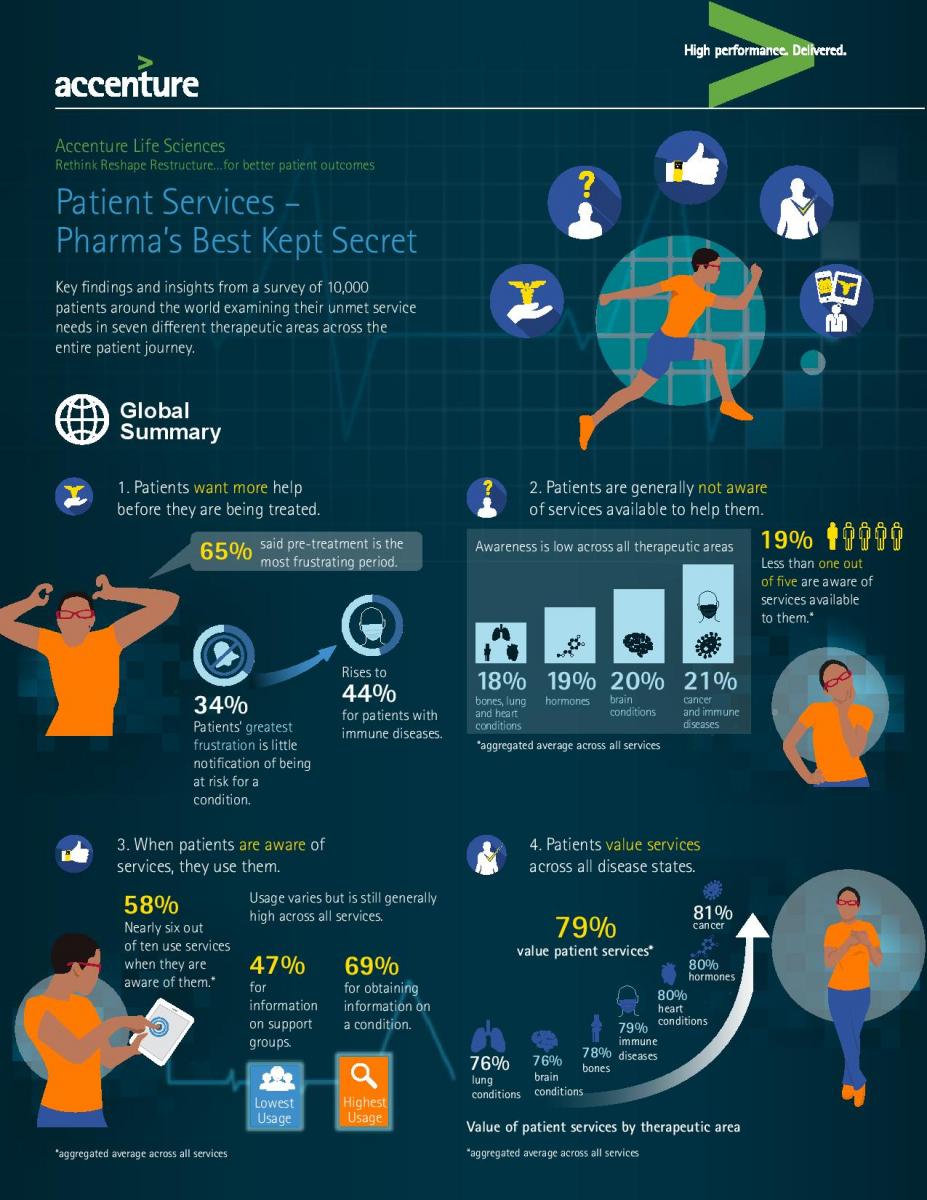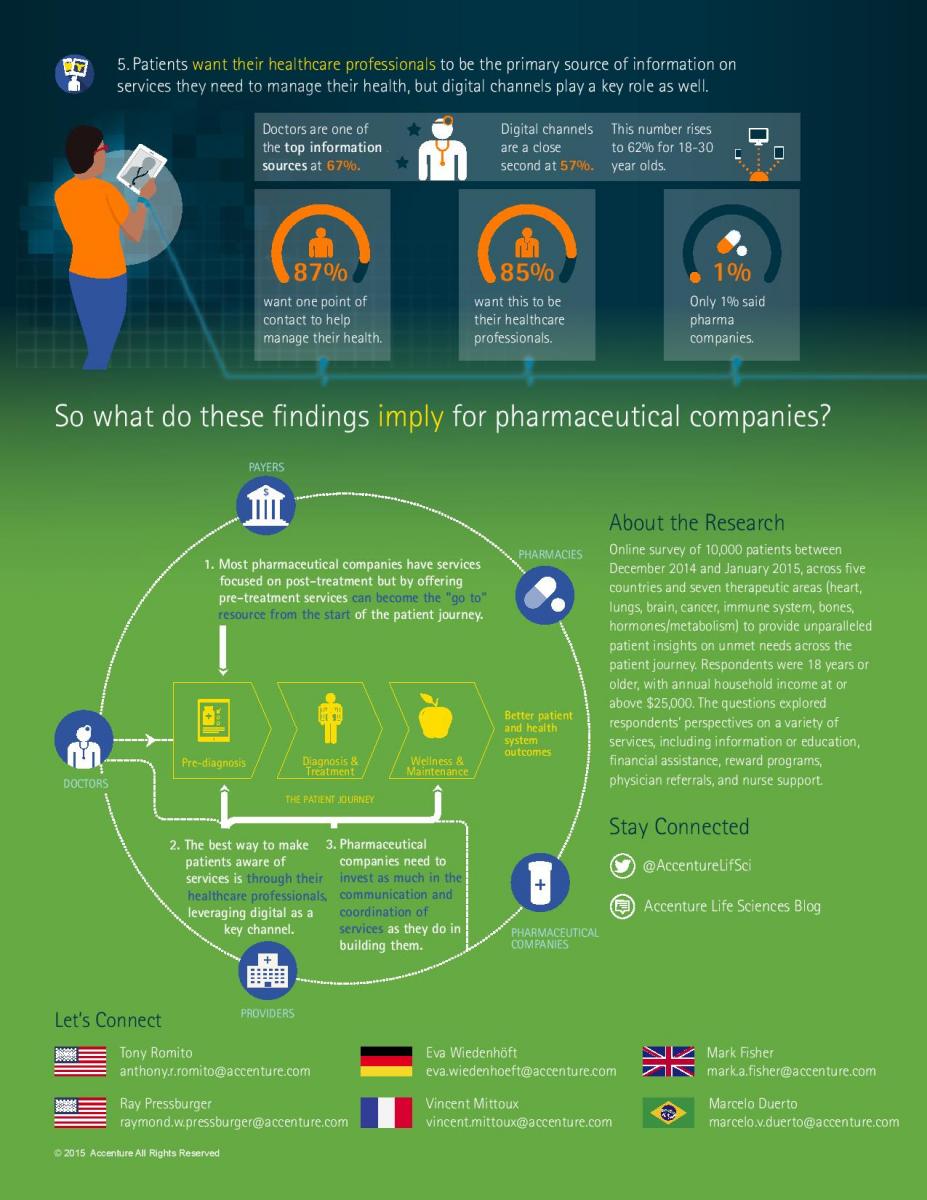Pharma Missing Out on Pre-Treatment Services Opportunity
By offering pre-treatment services, pharma can become the "go to" resource from the start of the patient journey.

In the treatment of most chronic or acute diseases, the active engagement of patients in the management of their own disease is critical to achieving positive outcomes – both clinical and economic. The reality for most patients is their personal care providers’ work within high-capacity and cost-constrained environments where getting even the most basic information can be challenging, much less having the sort of partnership required to fully engage and benefit the patient.
Often, engagement in diagnosis, confidence in the diagnosis, and having the treatment decision arrived in a consultative approach is crucial to sustaining commitment throughout the therapeutic journey and achieving good adherence".
A recent Accenture survey of 10,000 patients from the United States, United Kingdom, France, Germany and Brazil examined patients’ greatest unmet needs in seven different therapeutic areas across the entire journey – from symptoms, to pre-diagnosis, through to active treatment. The survey highlighted that one of the most frustrating and least effectively managed period is before patients are treated for a disease, regardless of disease type. Often, engagement in diagnosis, confidence in the diagnosis, and having the treatment decision arrived in a consultative approach is crucial to sustaining commitment throughout the therapeutic journey and achieving good adherence. What was equally striking is that while resources are available to patients, few were aware of their existence or how they might be accessed. In the limited number of cases where patients are aware of a service, they use and highly value them across all therapeutic areas surveyed.
Fact 1: A patient’s information and support needs are high before being treated
The timing of where patient services are provided across the patient journey has emerged as a critical issue for patients. The global survey found that nearly two-thirds (65 percent) of all patients surveyed indicated the pre-treatment interval is the most frustrating period for them. Their single biggest frustration is the lack of notification of being at risk for a condition. The global survey found 34 percent of patients across all therapeutic areas were frustrated they had little warning that they could be diagnosed with a condition. This percentage rose to 44 percent for patients surveyed with immune diseases.
Fact 2: Patients are generally not aware of the services that are available to help them
Between news reports of the latest clinical studies, profiles of surgical breakthroughs and coverage of health-related threats, it may seem like every media channel and platform provides a steady stream of health information around the world. But the opposite is apparently true when it comes to patient services. The survey found that on average, less than one out of five patients (19 percent) are aware of the services available to them (see Figure 2 of the infographic below). What’s more, awareness is low across all therapeutic areas, ranging from a low of 18 percent for bone, lung and heart conditions to a slightly higher 21 percent for cancer and immune diseases.
Fact 3: When patients are aware of services, they use them
The opportunity to reverse such low awareness of patient services is particularly compelling because patients who are aware of patient services do in fact use them. The survey found that nearly six out of 10 patients (58 percent) use services when they are aware of them. While usage of specific patient services varies, utilization is still generally high across all services provided. Within the survey population, the use of services ranged from a high of 69 percent for services that helped patients obtain information on a condition, to a low of 47 percent for information on support groups.
Fact 4: Patients value services across all major diseases
Patients not only use the services once they are aware of them, but they also find great value in the services that they use— no matter what health condition they are facing. The vast majority (79 percent) of survey respondents said the services they used were “‘very” or “extremely” valuable. This high level of satisfaction is seen across all disease states, with patients contending with diagnoses that range from life-threatening in the cases of cancer or heart problems, to chronic conditions such as auto-immune or hormonal disorders.
Fact 5: Patients want their healthcare professionals to be the primary source of information on services they need to manage their health, but digital channels are becoming increasing credible and important
An overwhelming majority of patients (87 percent) stated they wanted a single point of contact to provide a service to help them manage their condition. The vast majority (85 percent) would like that to come from their healthcare professionals. Only six percent would seek information about services from their insurance company, while that number drops to one percent for pharmaceutical companies.
While in-person visits with doctors remain the top means from which patients gain information (67 percent), digital channels are gaining ground and are a close second, mentioned by 57 percent of respondents. Further, younger individuals (18-30 years old) are even more receptive to digital channels with 62 percent ranking them in the top three preferred sources of information.
Insights to move forward
The research unveils there is clear opportunity for pharmaceutical companies to increase their value to patients by increasing awareness, and ultimately the use of patient services—and to start doing so much earlier in the patient journey.
These findings imply the following insights and actions for pharmaceutical companies:
-
Most life sciences companies have services focused post-diagnosis, but by offering pre-treatment services, they may effect a stronger partnership with physicians and patients. By providing critical services and resources at the point when physicians and patients are seeking the most relevant data and have the greatest angst, life science companies have an opportunity to influence value for the patient and health system – selecting the right treatment for that individual and gaining their active engagement in achieving optimum outcomes.
-
The best way to make patients aware of services is through high credibility partnerships with healthcare professionals, leveraging digital as a complementary channel. Given that today there are over 1,000 digital apps offered directly to patients by life science companies, with very low utilization, we do not believe this to be a viable strategy. With healthcare professionals as patients’ most trusted advisor, they are the natural conduit to making patients aware of the services available to them.
-
Life Science companies need to invest more in the quality and effectiveness of their services. Most life sciences companies are launching services and apps for patients at an accelerating rate. The costs and barriers to development and launch are both low. We believe life science companies need to rethink how they conceive, launch, support, communicate, and coordinate their services with healthcare professionals and the other key stakeholders including payers, providers, governments and pharmacies. These services need to integrate within the ecosystems and not skirt the periphery. Conversations need to shift from products to overall patient value and health system outcomes and how the combination of products and services can help achieve that those goals.
View the interactive infographic: Patient Services: Pharma’s Best Kept Secret Infographic
Editor’s Note:
Accenture retained Coleman Parkes Research Ltd. to conduct an online survey of 10,000 respondents in the United States, United Kingdom, France, Germany and Brazil (2000 per country) between December 2014 and January 2015. Respondents were 18 years or above, with annual household income of $25K or above. For each country, we surveyed a minimum of 150 patients each with conditions affecting the heart, lungs, brain, immune system, the bones or any organs, hormones/metabolism and any area of cancer. The questions explored respondents’ perspectives on a variety of services, including information or education, financial assistance, reward programs, physician referrals, and nurse support.



